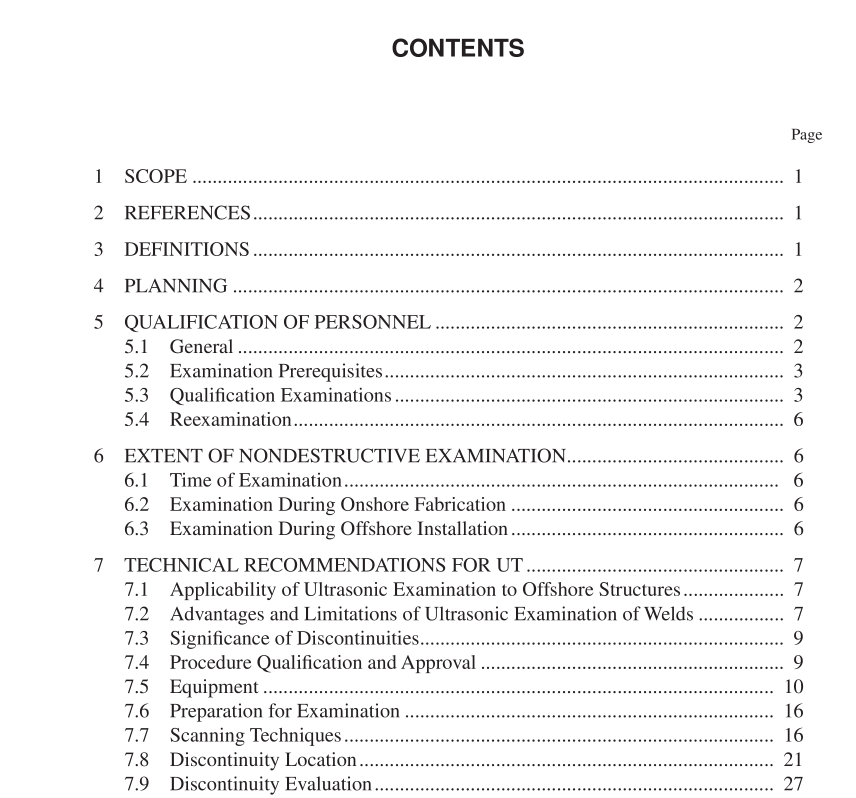API RP 2X pdf download

API RP 2X pdf download.Recommended Practice for Ultrasonic and Magnetic Examination of Offshore Structural Fabrication and Guidelines for Qualification of Technicians
1 Scope
This recommended practice (RP) for nondestructive exam- ination (NDE) of offshore structural fabrication and guide- lines for qualification of personnel contains guidance on NDE methods which have evolved from fabrication experience with offshore structures. These methods are commonly used and have found acceptance due to their reliable detection of discontinuities. The five NDE methods routinely used in off- shore structural fabrication are visual (VT), penetrant (PT), magnetic particle (MT), radiography (RT), and ultrasonic (UT) examinations. This recommended practice primarily addresses the MT and UT methods. Guidance on VT, PT and RT is incorporated by reference to ANSI/AWS D1.1. Further recommendations are offered for determining the qualifica- tions of personnel using MT and UT techniques. Recommen- dations are also offered for the integration of these techniques into a general quality control program. The interrelationship between joint design, the significance of defects in welds, and the ability of NDE personnel to detect critical-size defects is also discussed. THIS DOCUMENT IS NEITHER A CODE NOR A SPEC- IFICATION AND SHOULD NOT BE UTILIZED AS SUCH BY THE OPERATOR
3 Definitions
The welding terminology used herein is defined in the American Welding Society publication A3.0. Relevant ultra- sonic terminology is defined in the Glossary section, Appendix E, of this document. Other definitions of interest are tabulated in the following. For the purpose of this stan- dard, the following definitions apply: 3.1 acceptance criteria: Limit of shape, size, and posi- tion of discontinuities acceptable within the context of the specific design requirements. 3.2 agency personnel: Personnel employed and trained by an independent organization, offered to the Operator on a contract basis, for assisting in the construction inspection. 3.3 certification: Written testimony of qualification. 3.4 designer: The person, firm, corporation, or other orga- nization employed by the Operator during fabrication and installation with responsibility for examining all details of fab- rication to ensure compliance with construction specifications. 3.5 inspector: The individual representing the Operator during fabrication and installation with responsibility for examining all details of fabrication to ensure compliance with construction specifications. 3.6 NDE examination: An examination of materials and fabrication by qualified personnel responsible to the inspector using equipment for the purpose of locating and sizing discontinuities in materials or welds and reporting such findings to the inspector for evaluation of compliance with the acceptance criteria. 3.7 NDE examination procedure: The detailed writ- ten procedure outlining the specific examination techniques and criteria to be utilized during the construction of a partic- ular structure. 3.8 NDE specialist: An individual with extensive expe- rience in the preparation and application of nondestructive examination procedures. Typically an individual classified by the American Society for Nondestructive Testing as a Level III or equivalent. An NDE specialist may be certified in one or more NDE methods (that is, MT, UT, RT, and so forth). 3.9 operator: The person, firm, corporation, or other organization employed by the owner to oversee the con- struction and/or operation of the facility. 3.10 qualification: Demonstrated skill and knowledge and documented training and experience required for per- sonnel to properly perform the duties of a specific job.
4 Planning
4.1 These recommendations are intended to serve as guidelines for establishing a controlled program of nonde- structive examination by magnetic particle and ultrasonic methods during fabrication and installation of offshore facilities. They are intended to be used in the context of a comprehensive fracture control plan that includes design philosophy and material selection as well as NDE. IT IS INTENDED THAT THE OPERATOR’S NDE SPECIAL- IST DEVELOP DETAILED PROCEDURES FOR EXAM- INATION. THESE DETAILED PROCEDURES SHOULD DRAW ON THE TECHNICAL GUIDANCE IN SEC- TIONS 7 AND 8, TOGETHER WITH PERSONNEL QUALIFICATIONS AS DESCRIBED IN SECTION 5, WHICH SHOULD PROVIDE THE TECHNICAL BASIS FOR A NONDESTRUCTIVE EXAMINATION PROGRAM. 4.2 These recommendations assume that the design of the structure is performed in accordance with the API Recom- mended Practices 2A-WSD or 2A-LRFD. The operator and the designer should recognize the potential that undetected flaws may exist in the structure even after inspection and examina- tion by qualified personnel. In establishing NDE requirements, consideration should be given to the ease or difficulty of suc- cessful joining of specific details, accessibility by other exami- nation methods, feasibility of repair, and the significance of a failure to structural integrity. Both the extent of the examination and the acceptance criteria are closely related to these issues.









